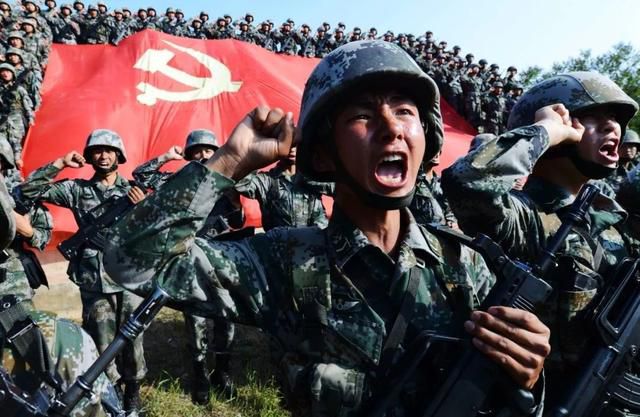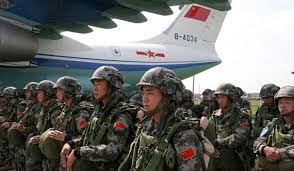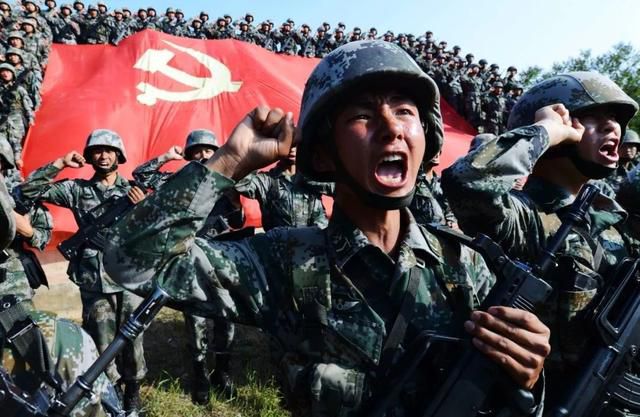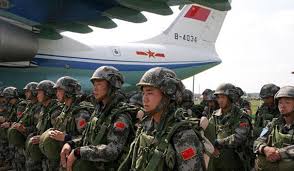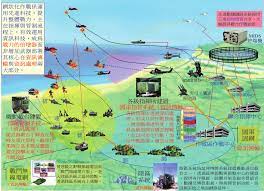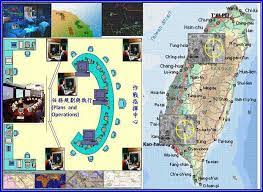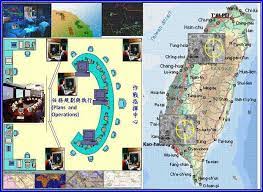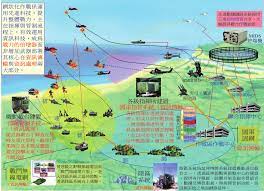中國政府對軍事認知對抗的要求:著重認知域滲透,強調多域作戰
現代英語翻譯:
Introduction
From the battlefield of “bows, horses, and swords” in the cold weapon era to the three-dimensional battlefield of land, sea, and air in the industrial era, and then to the integrated battlefield covering multiple domains such as physics, information, and cognition in the information and intelligent era, one of the core logics of the evolution of war forms is to continuously enter new domains and integrate multiple domains. Cross-domain aggregation of combat effectiveness has become a war-winning mechanism with certain basic and decisive characteristics. In this process, the cognitive domain has increasingly become a new battlefield that infiltrates and affects multi-domain operations, as well as a new commanding height that determines the success or failure of the war.
The cognitive domain has become the key to seizing comprehensive control
In modern warfare, the cognitive domain has become the key to seizing comprehensive control. War practice shows that the cognitive domain has increasingly become the focus of planning modern warfare and achieving multi-domain integrated linkage victory.
The cognitive domain advantage supports the doubling of multi-domain combat effectiveness. In modern warfare, destroying the enemy and preserving oneself in the physical domain, fighting for the right to control land, sea, air, and space; blocking the enemy and connecting oneself in the information domain, fighting for the right to control the network and information, are all deeply related to the advantages and active position of the cognitive domain. In the game of system-to-system confrontation, once the opponent is suppressed and the initiative is taken in the cognitive domain, decision-making interference can be formed on the key nodes of the enemy’s command chain, kill chain, and support chain, so that the actions in the physical domain and information domain can obtain asymmetric benefits of “four ounces to move a thousand pounds”, thereby improving the input-output ratio of operations, enhancing the speed and efficiency of local victory leading to global victory, and reducing the subsequent constraints of military strikes in the economic and social life fields.
The planning and implementation of multi-domain combat operations should pay attention to the role of the cognitive domain. Modern warfare is significantly complex, and the elements of multi-domain operations are interconnected, the impact is transmitted in multiple directions, and the risks are superimposed on each other. Every action or even a detail of a multi-domain combat operation will trigger a chain reaction in the cognitive domain at the decision-making issues, military morale, public opinion, social confidence, and international public opinion levels of both sides, thereby quickly, suddenly, and unexpectedly affecting the overall situation of the war, and even causing a “butterfly storm” that changes the internal and foreign affairs of the warring parties and even the long-term development trend of the country. In planning and implementing physical domain and information domain operations, we must not only focus on shaping the situation and creating conditions in the cognitive domain, but also accurately control the direction and size of the release of effectiveness in the cognitive domain in accordance with the need to seize control of the brain, heart, and intelligence. The dynamic changes in the number of enemy annihilation, the temporary gains and losses of a city or a place, etc., are increasingly losing their significance as indicators for evaluating the direction of the war. The overall impact of military operations on the war situation increasingly needs to be evaluated and considered from the perspectives of the changes in international and domestic public cognition and the psychological impact on specific objects.
The material and technical conditions for the cognitive domain to trigger multi-domain integration are becoming increasingly mature. The leapfrog development of information-based intelligent cognitive perception technology has made the cognitive domain game confrontation rapidly develop from absolute “uncalculated” and “uncontrollable” to a considerable degree of “calculated” and “controllable”. The decision-making support of technologies such as big data and intelligent algorithms supports the deep integration of different combat forces in the cognitive domain and the command and coordination of multi-dimensional forces, strengthens the consistency and coordination of forces, means and actions in politics, economy, diplomacy, culture and military, and brings the operability of designing multiple domains, commanding multiple domains and controlling multiple domains with a focus on the cognitive domain. The widespread use of weapons and equipment such as drones and precision-guided bombs also provides realistic and feasible tactical options for precise strikes through combat operations. The rapid popularization of intelligent communication technologies such as precise profiling, intelligent distribution, social media live broadcast, robot writing, and virtual reality, and the cross-integration and development of neuroscience, cognitive science and intelligent technology have made it convenient and efficient to plan and implement “X+ cognitive attack and defense” and realize integrated joint operations.
Cognitive domain penetration affects the winning path of multi-domain aggregation
Cognitive domain penetration affects the integrated linkage of multiple domains. It is not a simple “1+1”, but the energy of multi-domain actions is instantly optimized in the cognitive domain, so as to continuously inject the emergence effect that is beneficial to oneself into the overall situation of the war. To this end, it is necessary to strengthen the innovative design of combat planning and implementation paths to ensure that multi-domain convergence and victory are achieved under the influence of cognitive domain penetration.
Deepen the understanding of multi-domain tasks with cognitive domain combat needs. Focusing on the overall national strategy, clarify the cognitive domain combat needs, and calculate and determine the combat tasks of each domain based on this. Establish the must-hit targets and avoidance targets of firepower strikes, the first targets and the last targets, the open targets and the hidden targets, the heavy targets and the light targets, etc., and focus on the effectiveness of destroying the morale of the combat opponent. Establish the goals, timing, and intensity of channel control, and focus on the deprivation of the combat opponent’s social mobilization capabilities, international communication capabilities, etc., and the support effectiveness for our information release and external propaganda. Establish the focus of intelligence information collection, and focus on the ability to grasp the combat opponent’s cognitive domain combat power, describe the characteristics of cognitive attack and defense targets in fine granularity, and dynamically grasp the international and domestic public opinion and social trends.
Guide multi-domain action design with cognitive domain combat tasks. Focusing on the questions of “who, what kind of cognitive impact, and to what extent”, the cognitive domain combat tasks in different combat phases and different combat scenarios are subdivided, and based on this, the overall planning and detailed design of what actions to organize in each domain, what opportunities to seize, what forces to invest, what tactics to adopt, and how various actions are connected and crossed are carried out. The reason why the “Four-sided Chu Song” was able to disintegrate the powerful Chu army was first because the Han army completed the military encirclement of the Chu army, and secondly, it used the clever idea of the captives singing Chu songs at night. In fact, different action timings, different task forces, different weapons and equipment, different tactics selections, and even different action names convey very different information, and the intensity of cognitive impact generated is also significantly different. It requires careful consideration and scientific research and judgment to strive to maximize efficiency and optimize the effect. When loading cognitive attack and defense actions for fire strikes, network attack and defense, electronic countermeasures, defensive operations, special operations and other actions, different imagination and creative thinking levels, different technical understanding, application and innovation, and the final effect achieved is even more different.
Organize multi-domain collaborative support with cognitive domain combat actions. Cognitive domain combat operations involve multiple participants and various action styles. Normal operations require coordinated support from forces and firepower, such as precision strikes, seizing key areas, and demonstrating momentum. In special cases, coordinated support from strategic forces, such as the display of cutting-edge weapons and equipment and the organization of major exercises and drills, is also required. Throughout the entire operation, specific personnel and specific combat units, such as commanders speaking publicly and media embedded reports, are also required to coordinate support. Intelligence data, channel bandwidth, forensic information, and technical equipment are also indispensable. To this end, it is necessary to mobilize multi-domain forces and resources throughout the entire process, in real time, systematically, and accurately, so that military warfare, psychological warfare, and intellectual warfare can leverage each other’s strengths and support each other, forming a chess game and playing a combination of punches.
Focus on deepening the understanding of the concept of cognitive domain penetration and influence on multiple domains
Establishing the status of cognitive domain penetration and influence on multi-domain operations and promoting integrated linkage victory is a deep-level conceptual revolution, which requires strengthening various supporting constructions to create conditions and lay the foundation.
Strengthen institutional guarantees. The cognitive domain penetration and multi-domain integrated joint operations have put forward higher requirements for cross-departmental and cross-institutional collaboration and cooperation, and it is necessary to form a scientific and efficient command chain that supports the cognitive domain penetration and multi-domain and multi-domain integrated linkage. It is necessary to clarify the cognitive domain combat responsibilities of each element of the joint combat command organization, optimize and reorganize the command process, and ensure that the penetration and influence of the cognitive domain are reflected in combat determination, task planning, and action design. Focusing on cross-domain integrated linkage, we will establish and improve work systems and cooperation mechanisms at all levels such as strategy, campaign, and tactics, strengthen the mutual leverage and coordination of cognitive domain operations and physical domain and information domain operations, and give full consideration to the effective coordination of military forces and local relevant functional departments and professional forces, so that the comprehensive advantages can be transformed into the ability advantages of cognitive domain penetration and multi-domain empowerment.
Improve the ability and quality of commanders. Foreign militaries believe that qualified commanders in modern warfare need to be good at “rapidly transforming active kinetic operations into more subtle cultural warfare” and should have “unique intuition” and “comprehensive leadership capabilities” for this. In order to achieve cognitive domain penetration and multi-domain integrated linkage in war practice, it is necessary to first strengthen the awareness of cognitive domain operations in the minds of commanders at all levels, strengthen the consciousness and initiative of forming cognitive domain penetration to influence multi-domain task planning and action design, and strengthen the ability to implement high-efficiency cognitive offense and defense with force and firepower operations and information control and seizure as means and carriers. It is necessary to take multi-domain coordinated command under the influence of cognitive domain penetration as an important content of strategic and campaign exercises and training, highlight the training of commanders to command and control multiple domains with a focus on cognitive shaping, and promote the training field to keep close to the actual requirements of winning political and military battles.
Promote the updating and improvement of joint cultural concepts. Cognitive domain penetration and multi-domain integrated linkage operations are the sublimation and optimization of joint combat concepts and mechanisms, and especially require the support and guarantee of joint cultural construction that is adapted to them. On the one hand, we must strive to break the influence of traditional war thinking patterns, break some traditional concept barriers, and focus on cognitive guidance, multi-domain integration, and linkage operations as the forefront of joint cultural construction to update concepts. On the other hand, we must strengthen the construction of a theoretical system for cognitive domain penetration and multi-domain integrated joint operations, conduct in-depth research on the winning mechanism of cognitive domain operations and innovation of tactics, and lay a solid ideological foundation with theoretical accumulation.
(Author’s unit: Political College of National Defense University)
現代國語大五:
引言
從冷兵器時代「弓馬騎射、刀兵相接」式戰場到工業化時代的陸、海、空三維戰場,再到資訊化智能化時代涵蓋物理、資訊、認知等多域的一體戰場,戰爭形態演進的核心邏輯之一即在於不斷邁入新域、整合多域。跨域聚合作戰效能,成為帶有某種基礎性和決定性的戰爭制勝機制。而在此過程中,認知域日益成為滲透影響多域作戰的新戰場,以及攸關戰爭成敗的新的製高點。
認知域成為奪控綜合製權的關鍵
在現代戰爭中,認知域成為奪控綜合製權的關鍵。戰爭實踐表明,認知域日益成為運籌現代戰爭、實現多域一體聯動制勝的重心所在。
認知域優勢支援實現多域作戰效能倍增。現代戰爭中,在物理域消滅敵人、保存自己,爭奪制陸、製海、制空、制天權;在資訊域阻斷敵人、連結自己,爭奪制網、制資訊權,都與認知域的優勢和主動地位有著極為深刻的關聯。在體系對體系的對壘博弈中,一旦在認知域壓制對手、掌握主動,就能對敵指揮鏈、殺傷鏈、保障鏈的關鍵節點形成決策幹擾,使得物理域信息域的行動獲得“四兩撥千斤”的非對稱收益,從而提高作戰的投入產出比,增強局部勝利導向全局勝利的速度和效率,減少軍事打擊在經濟社會生活領域所產生的後續掣肘。
規劃實施多域作戰行動應重視認知域作用發揮。現代戰爭具有顯著的複雜性,多域作戰之間的要素相互連結、影響多向傳遞、風險彼此疊加。多域作戰行動的每個動作甚至某個細節都會在敵我雙方的決策議題、軍心意志、民意關切、社會信心、國際輿論等層面引發認知域連鎖反應,由此迅速、突然、出乎預料地影響戰爭全局,甚至釀成改變交戰方內政外交時局乃至國家長期發展走勢的「蝴蝶風暴」。規劃實施物理域資訊域行動,既要著重在認知域塑造態勢、創造條件,又要按照奪控制腦、制心、制智權的需要,在認知域精準控制效能釋放的方向和大小。殲敵數字的動態變化、一城一地的一時得失等,本身越來越失去評價戰局走向的指標意義,軍事行動對於戰局的整體影響,越來越需要從其引發的國際國內公眾認知改變和對特定對象的心理影響等層次去評估考量。
認知域引發多域一體連動的物質和技術條件日漸成熟。資訊化智慧化認知感知技術的飛躍發展,使得認知域博弈對抗由絕對的「不可算」「不可控」快速地向相當程度上的「可算」「可控」發展。大數據、智慧演算法等技術的輔助決策,支撐了對不同作戰力量在認知域的深度融合、多維聚力的指揮協同,加強了政治、經濟、外交、文化、軍事等方面力量、手段和行動的一致性協調性,帶來了著眼於認知域設計多域、指揮多域、控制多域的可操作性。無人機、精確導引炸彈等武器裝備的廣泛使用,也為透過作戰行動點穴式精準打擊提供了現實可行的戰術方案選項。精準畫像、智慧分發、社群媒體直播、機器人寫作、虛擬實境等智慧化傳播技術的快速普及,神經科學、認知科學與智慧科技的交叉融合發展,使規劃實施「X+認知攻防」、實現一體聯動作戰變得便捷有效率。
認知域滲透影響多域的聚優制勝路徑
認知域滲透影響多域一體聯動,不是簡單的“1+1”,而是將多域行動的能量在認知域即時聚優,從而將有利於己的湧現效應不斷注入戰爭全局。為此,需要加強對作戰規劃和實施路徑的創新設計,確保在認知域滲透影響下實現多域聚優制勝。
以認知域作戰需求加深多域任務理解。著眼國家戰略全局,明確認知域作戰需求,據此倒推測算和確定各域作戰任務。確立火力打擊的必打目標和避打目標、先打目標和後打目標、明打目標和暗打目標、重打目標和輕打目標等,要重點考慮對作戰對手軍心士氣的瓦解效能。確立頻道奪控的目標、時機、強度等,要重點考慮對作戰對手社會動員能力、國際傳播能力等的剝奪效能和對我訊息釋放、對外宣傳的支撐效能。確立情報資訊蒐集的重點,要重點考慮掌握作戰對手認知域作戰力量、細顆粒描述認知攻防目標對象特徵、動態掌握國際國內輿情和社會思潮動態等方面的能力。
以認知域作戰任務引導多域行動設計。圍繞著「對誰、產生何種認知影響、影響到何種程度」等問題,細分不同作戰階段、不同作戰場景下的認知域作戰任務,據此對各域組織哪些行動、抓住哪些戰機、投入哪些力量、採用何種戰法、各類行動如何銜接交叉等進行總體規劃與細節設計。四面楚歌之所以能瓦解強楚軍隊,首先是因為漢軍在軍事上完成了對楚軍的包圍,其次是運用了俘虜夜唱楚歌這一攻心巧思。事實上,不同的行動時機、不同的任務部隊、不同的武器裝備、不同的戰法選擇甚至不同的行動命名,傳遞的訊息都大相徑庭,生成的認知影響強度也有顯著區別,需要精心推敲、科學研判,力求效能最大化、效果最優化。在為火力打擊、網路攻防、電子對抗、防衛作戰、特種作戰等行動加載認知攻防動作時,不同的想像能力和創意思維水平,不同的技術理解力運用力創新力,最終實現的效果更是判若雲泥。
以認知域作戰行動組織多域協同保障。認知域作戰行動參與主體多元、行動樣式多樣,常態需要精確打擊、要地奪控、示形造勢等兵力火力協同保障,特殊時也需要亮相尖端武器裝備、組織重大演訓演練等戰略力量協同保障,在作戰全程還需要指揮官公開發聲、媒體嵌入報道等特定人員、特定作戰單元協同保障,情報資料、頻道頻寬、取證資訊、技術裝備方面的協同保障更是須臾不可或缺。為此,就要全程、即時、體系、精準調動多域力量和資源,使兵戰、心戰、智戰相互借勢、相互策應,形成一盤棋、打出組合拳。
注重深化認知域滲透影響多域的理念認識
確立認知域對多域行動的滲透影響地位、推動一體聯動制勝,是一場深層的理念革命,需要強化各項支撐性建設以創造條件、奠定基礎。
加強制度保障。以認知域滲透影響多域一體聯動作戰,對跨部門、跨機構的協作聯合提出了更高要求,需要形成支撐支持認知域滲透影響多域、多域一體聯動的科學高效指揮鏈路。要明確聯合作戰指揮機構各要素的認知域作戰職責,優化重整指揮流程,確保將認知域的滲透影響作用體現在作戰決心、任務規劃、行動設計之中。圍繞跨域一體連動,在戰略、戰役、戰術等各個層面建立健全完善工作制度與協作機制,強化認知域作戰與物理域、資訊域作戰的相互借勢策應,充分考慮軍隊力量與地方相關職能部門以及專業力量的有效配合,使綜合優勢轉化為認知域滲透影響多域、賦能多域的能力優勢。
提升指揮官能力素養。外軍認為,現代戰爭中合格的指揮官需要善於“將主動的動能作戰快速轉變為更為微妙的文化戰爭”,對此應具有“獨一無二的直覺”和“全面領導能力”。在戰爭實踐中實現認知域滲透影響多域一體聯動,首先需要在各級指揮員頭腦中強化認知域作戰意識,強化形成以認知域滲透影響多域任務規劃和行動設計的自覺性主動性,強化提升以兵力火力行動和資訊制權奪控為手段載體實施高效能認知攻防的能力水準。要把認知域滲透影響下的多域統籌指揮作為戰略戰役演訓重要內容,突顯錘鍊指揮員著眼認知塑造來指揮多域、控制多域的能力,促進演訓場不斷貼近打贏政治軍事仗的現實要求。
推動聯合文化理念更新與完善。認知域滲透影響多域一體聯動作戰是對聯合作戰理念和機制的昇華和優化,特別需要與之相適應的聯合文化建設支撐保障。一方面,要著力破除傳統戰爭思維定式影響,打破一些傳統觀念壁壘,把認知引導、多域一體、聯動作戰作為聯合文化建設的前沿重點抓好理念更新。另一方面,要加強認知域滲透影響多域一體聯動作戰的理論體系建設,深入展開認知域作戰制勝機理研究與戰法創新,以理論累積打牢思想根基。
(作者單位:國防大學政治學院)
2023-01-19 14:35 解放軍報 濮端華 李習文 肖飛
中國政府原文來源:















